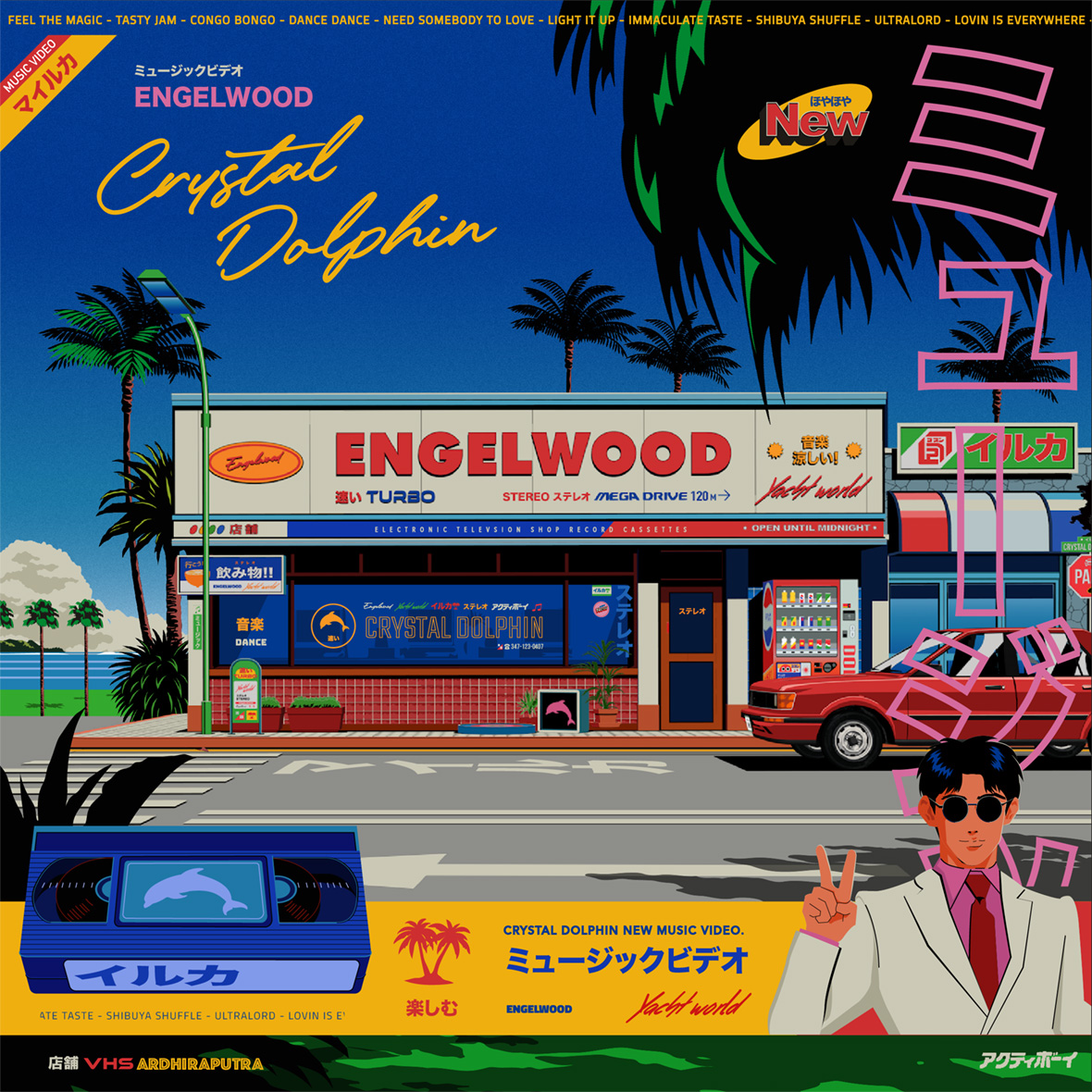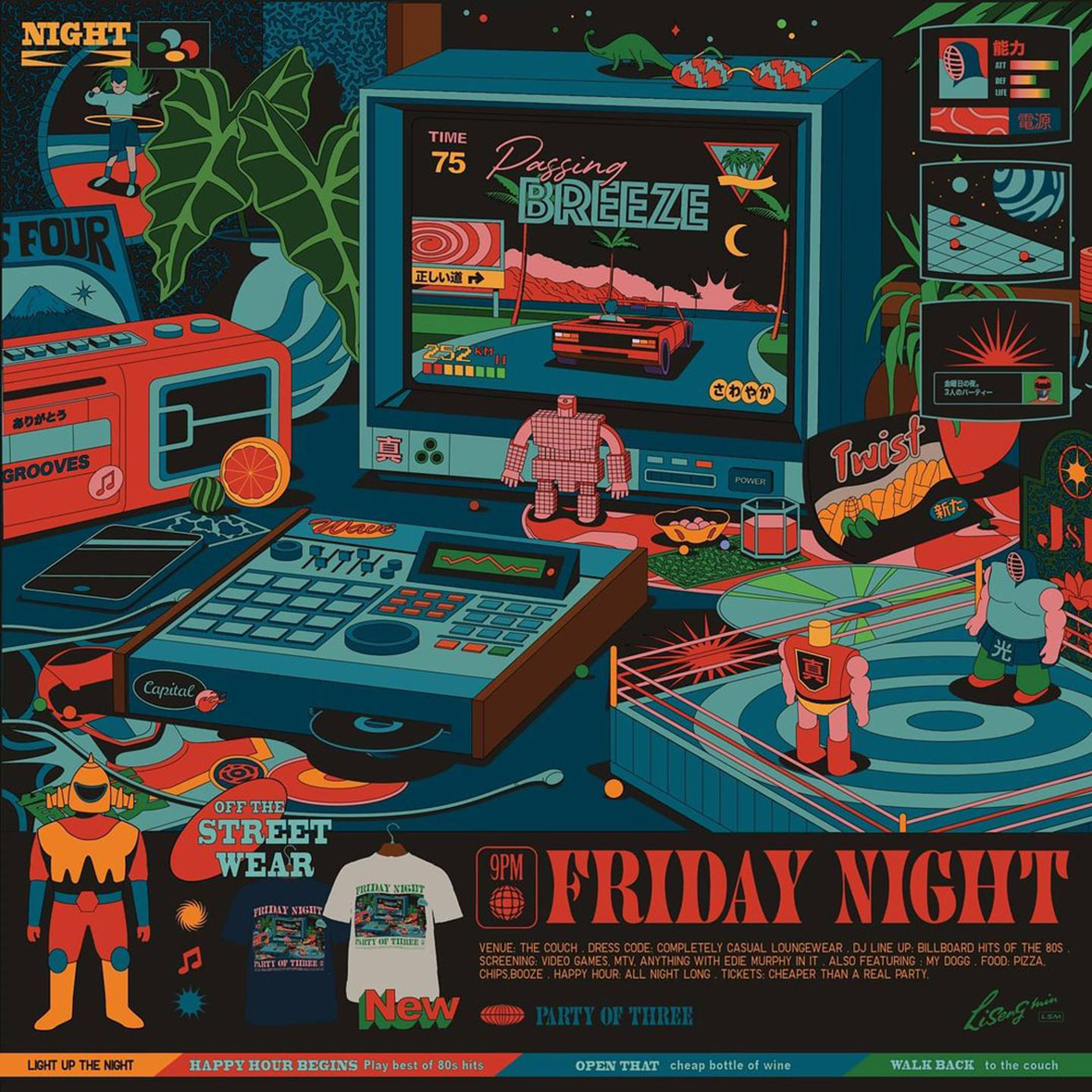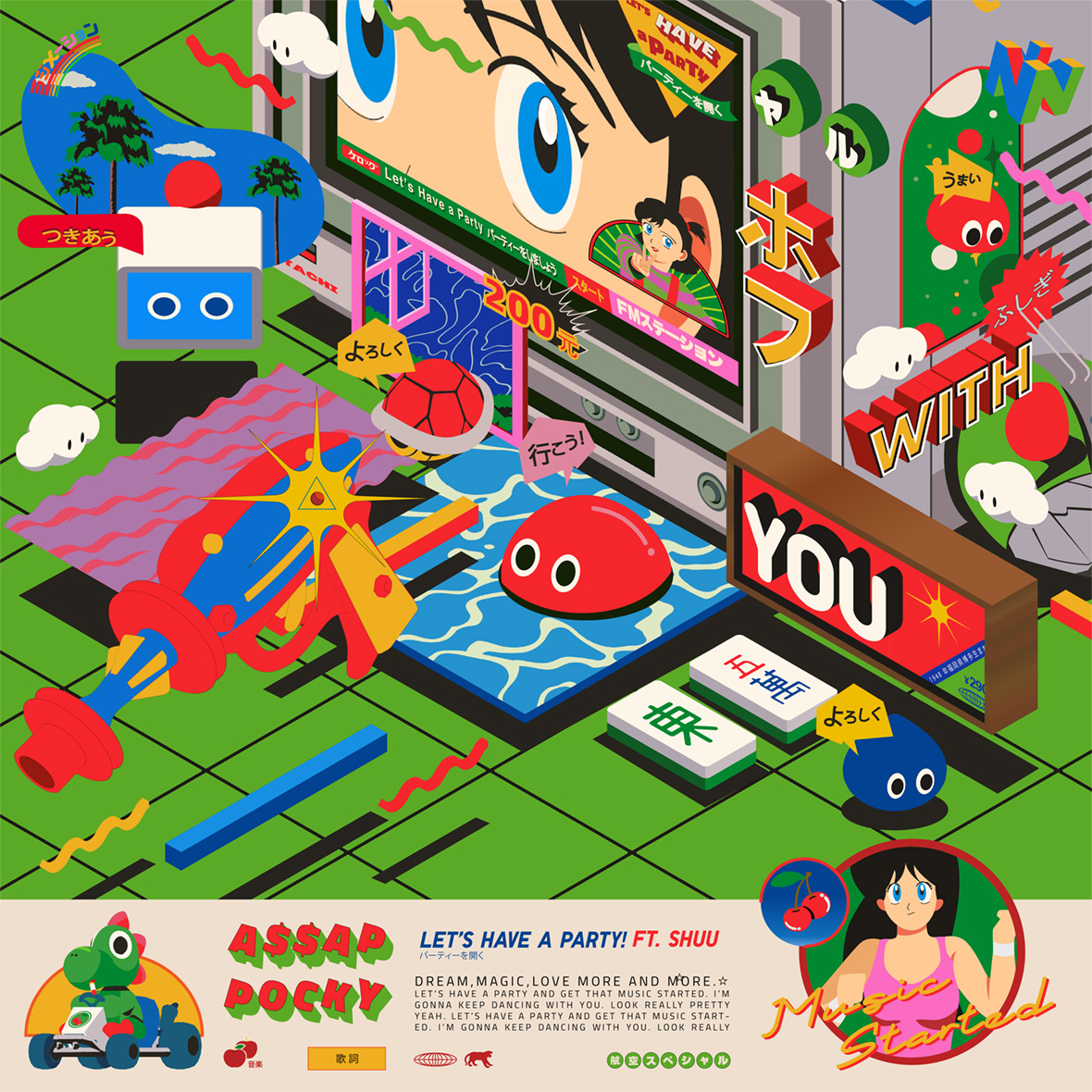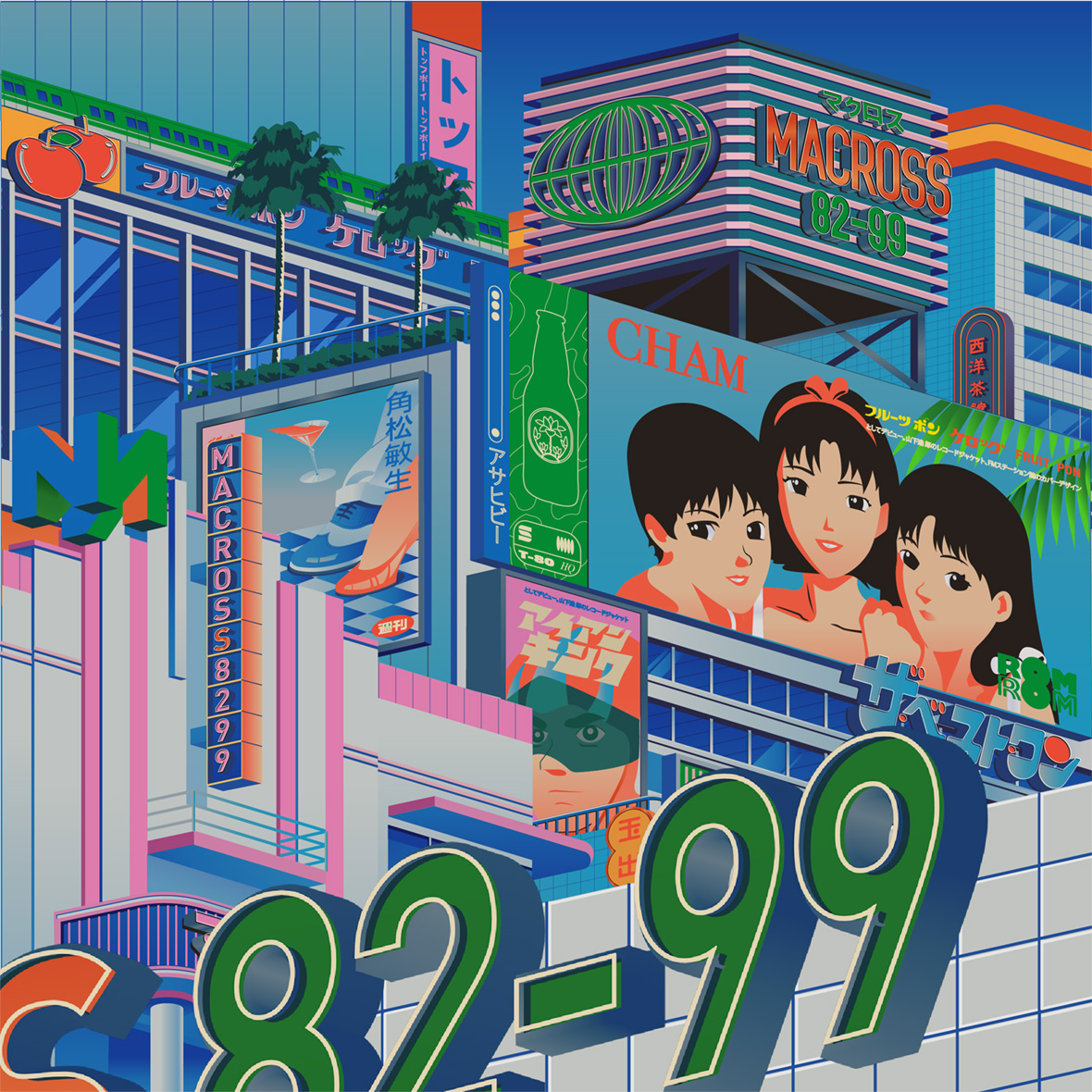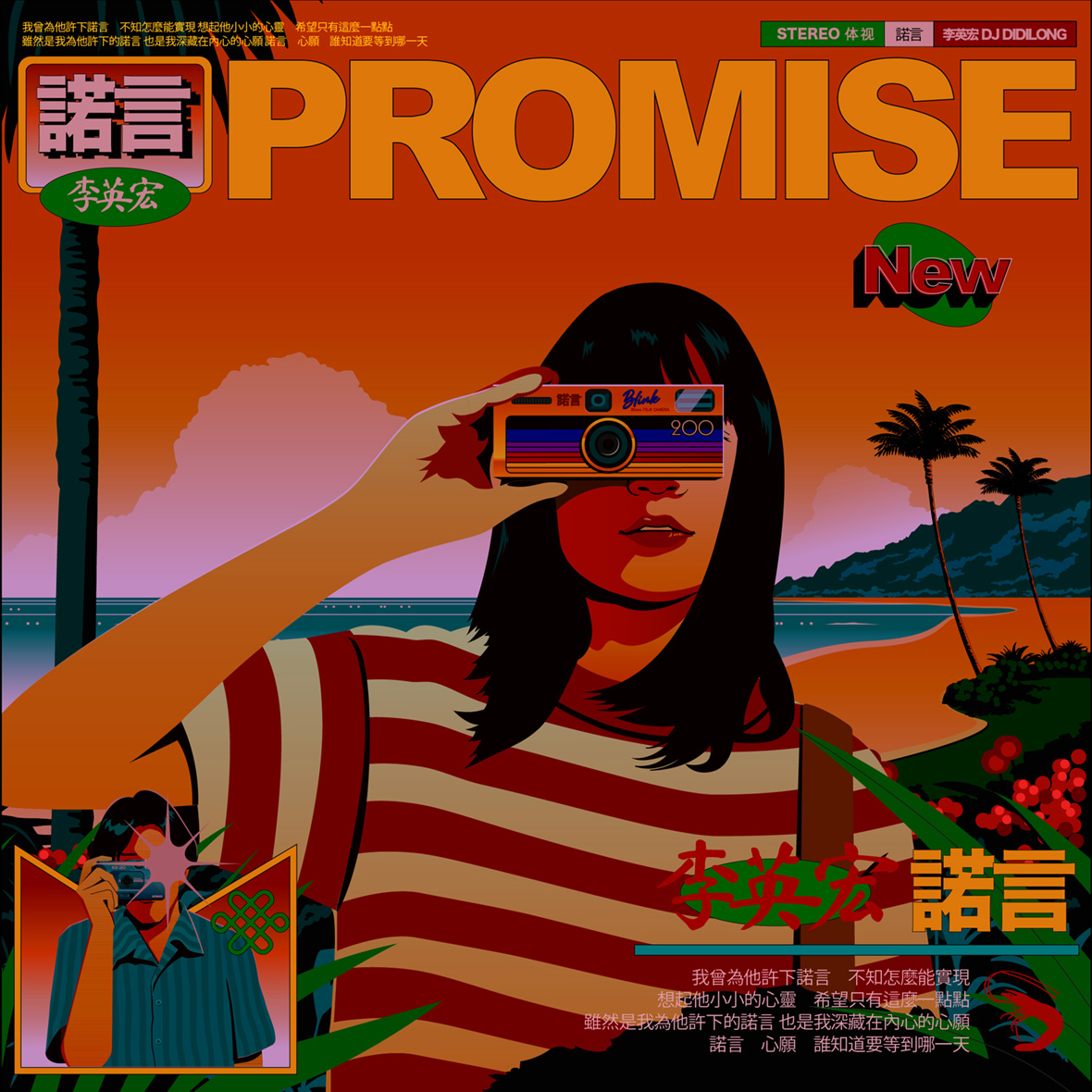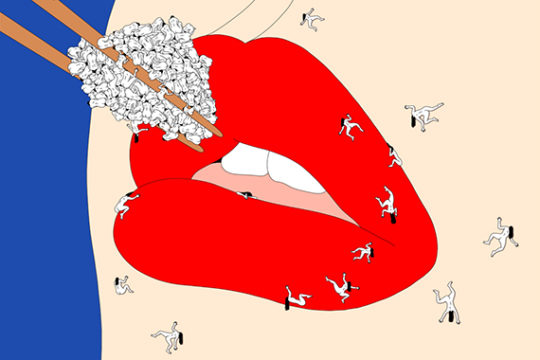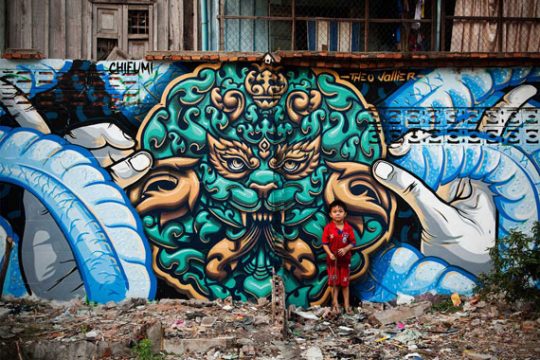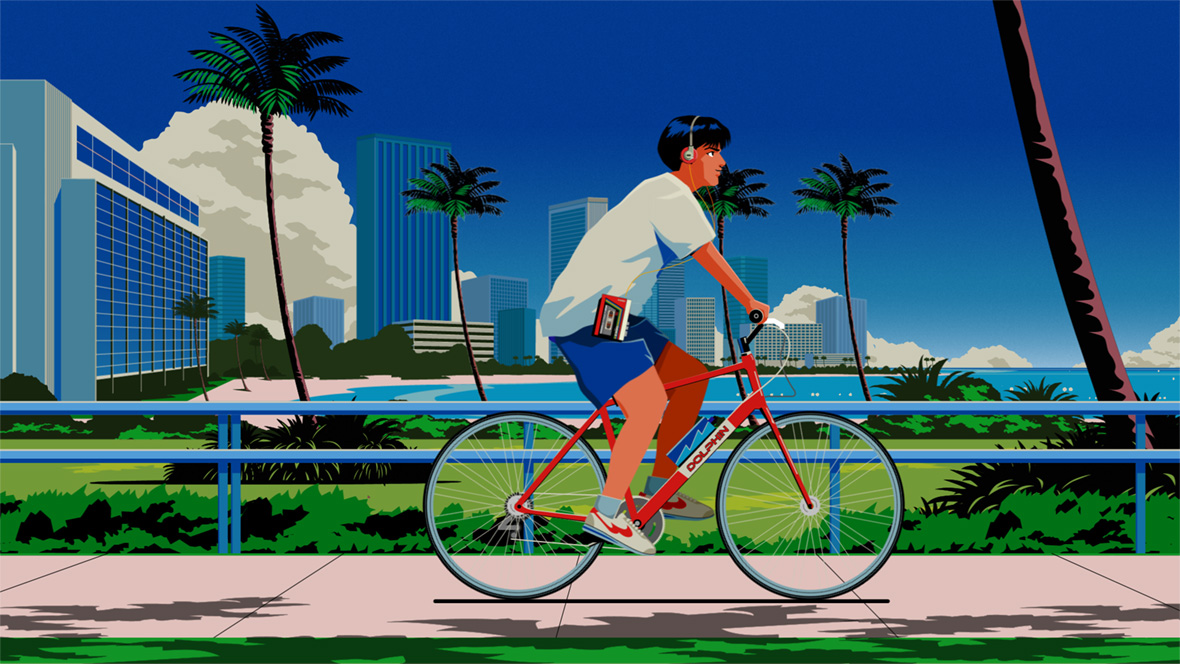
Through a VHS player, we enter the hyper-colored, funky universe of Ardhira Putra, a Singapore-based Indonesian artist who’s been turning his nostalgia into eye-popping works of art. He populates his illustrations and animations with characters, ad tags, and pop visuals inspired by the 1980s and 90s—all with a backdrop of swaying palm trees. This city pop style acts as a throwback to his beloved boyhood and the heydays of laissez-faire capitalism in Asia.
透过一台老旧的 VHS 家用录像机,进入 Ardhira Putra 色彩缤纷的复古黄金年代。这位现居新加坡的印尼艺术家将自己的怀旧情绪,转化成令人眼前一亮的艺术作品。他的插图和动画作品里洋溢着各种 20 世纪 80 至 90 年代的人物、广告牌和动感视觉元素,依稀可见那些随风摇曳的棕榈树、和霓虹灯下的酷炫跑车。他藉借城市流行 (City Pop) 风格,以丰富的颜色和线条,带观众重返他的童年,以及亚洲自由放任的资本主义鼎盛时代。
City pop is a music genre that emerged during the bubble years of the Japanese economy in the 1980s when the country became a commercial and tech powerhouse. It’s the local equivalent of easy-listening merged with funk in sophisticated arrangements and often with subtropical overtones. Its visual form appeared through album cover art. Both the musical experience and the art emote the spirit of capitalism, urban life, and the excitement of an era when life was described as an extravagant nonstop party. Putra’s work exudes such extravagance. It’s mainly composed of electric reds, blues, greens, and pink, and everything is tinged with a psychedelic touch, heightened by the infinite zoom effect he often adds to his animations.
City Pop 是 1980 年代日本经济泡沫时期出现的一种音乐类型,当时的日本已成为全球商业和科技强国。City Pop 糅合了令人放松的律动和放克元素,往往伴随亚热带海滨风情的感受。而在视觉层面,这一风格主要以专辑封面艺术的形式呈现。City Pop音乐及平面艺术都描绘了一种小资、都市以及资本主义繁荣的画风,令人对灯红酒绿的享乐生活浮想连连。Ardhira 的作品亦是如此,画面由鲜艳的红、蓝、绿、粉色填充,为画作披上了迷幻的外衣。而他作品中那种极繁风格,又进一步加强了迷幻的感受。
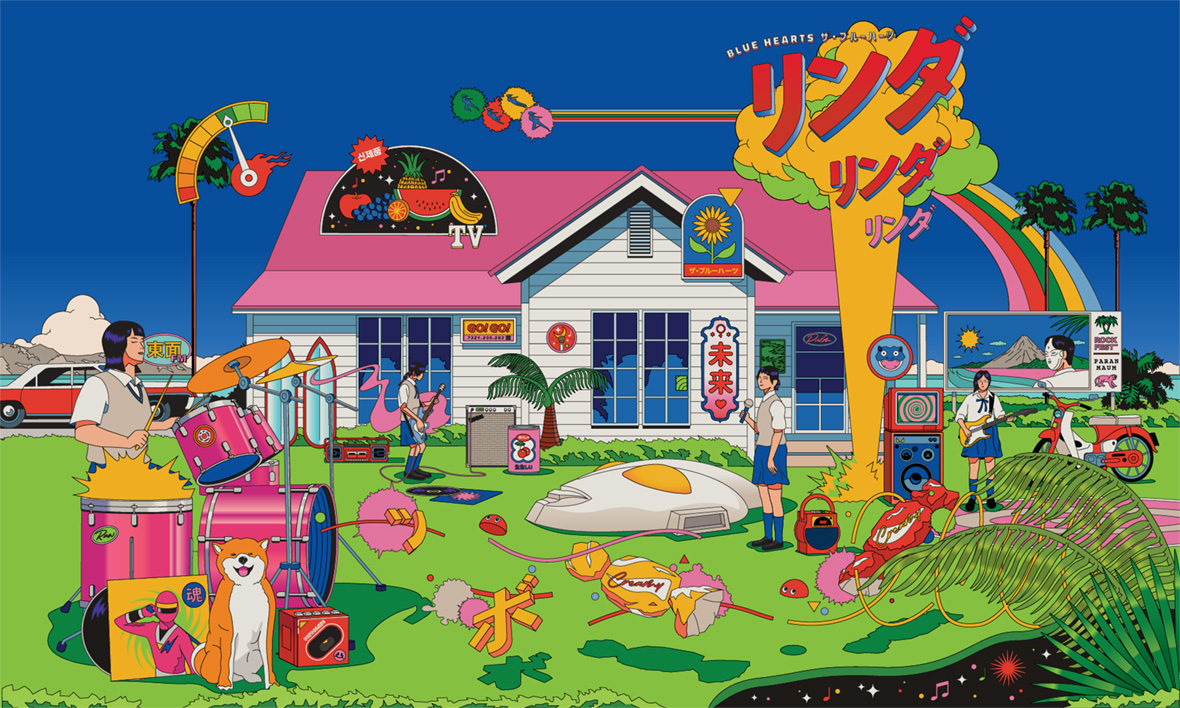
“Pop culture hit me hard when I was a kid,” Putra says. “Most of my inspirations come from vintage culture and Asian pop ads. They can be a billboard, an album cover, a TV commercial, my favorite cartoon when I was a child, or the games I played on Sega Saturn and Nintendo. My style is a step back in time with a combination of all these nostalgic references.”
He was born in 1988, at the beginning of Indonesia’s economic boom. Growing up in Jakarta, where most of the country’s prosperity was centralized, he saw the expanding consumption of the middle class. More and more Jakartans began dressing in designer clothes, driving imported cars, and dining at high-end restaurants. As consumerism was embraced, shopping malls took center stage in urban life, with their myriad of shiny new products vibrantly displayed in shop windows and adverts everywhere.
Ardhira 表示:“小时候,流行文化对我影响很大。现在大部分灵感都来自复古文化和曾风靡亚洲的广告,包括告示牌、专辑封面、电视广告、小时候爱看的卡通片等等,或者是世嘉和任天堂发行过的电子游戏。这些元素往往带观众重拾昔日的风采。”
生于 1988 年,自小在印尼最繁荣的城市——雅加达长大,当时正值印尼经济繁荣初期。在这里,他目睹了中产阶级不断扩大的消费欲,越来越多人开始身穿名牌服装,开进口车,到高档餐厅用餐。随着消费主义的兴起,购物中心成为城市生活的中心舞台,商店橱窗里摆放着琳琅满目的产品,形形色色的广告令人目不暇接。
It all happened as Indonesia progressively opened to foreign cultures and submitted to the soft power influences of the United States and Japan. Much of which was disseminated through television and radio. “My friends and I liked everything Japanese, from TV shows to video games and action figures,” Putra recalls. “Meanwhile, my parents loved to listen to Michael Jackson and Earth, Wind & Fire. On weekends, they would always take me to the mall.” This mishmash of childhood memories now all appear in his artwork in one way or another.
Until the early 1990s, Indonesian television was state-controlled, but then it opened up to many privately owned stations. One of them was MTV, whose iconic video idents instantly caught Putra’s eye and unleashed his fascination with motion graphics. He says he later pursued illustration and animation because, “I wanted my art to be consumed just like pop culture, like a comic book, a poster, or something you could watch on screen, all belonging to the same universe.”
随着当时印尼对外开放的步伐不断加快,当地逐渐深受美国和日本的文化影响。外国文化的影响主要都是通过电视和广播传播。Ardhira 回忆道:“从电视节目、电子游戏到玩偶模型,我和朋友迷上了各种日本文化。那时候我的父母则更喜欢听迈克尔·杰克逊和土风火合唱团 (Earth, Wind & Fire) 。每到周末,他们都会带我去逛商场。”直到今日,这些混杂的童年记忆仍然会以某种方式出现在他的作品中。
在 1990 年代初以前,印尼的电视节目都由国家管理,后来才慢慢向私营靠拢,人们可以在电视上观看类似 MTV 这样的频道。MTV 令 Ardhira 眼前一亮,更激发了他对动画的兴趣。他说,自己之所以后来去学插图和动画,就是因为“希望我的作品像流行文化一样被人们消费,就像漫画书、海报,或出现在电视屏幕上。”
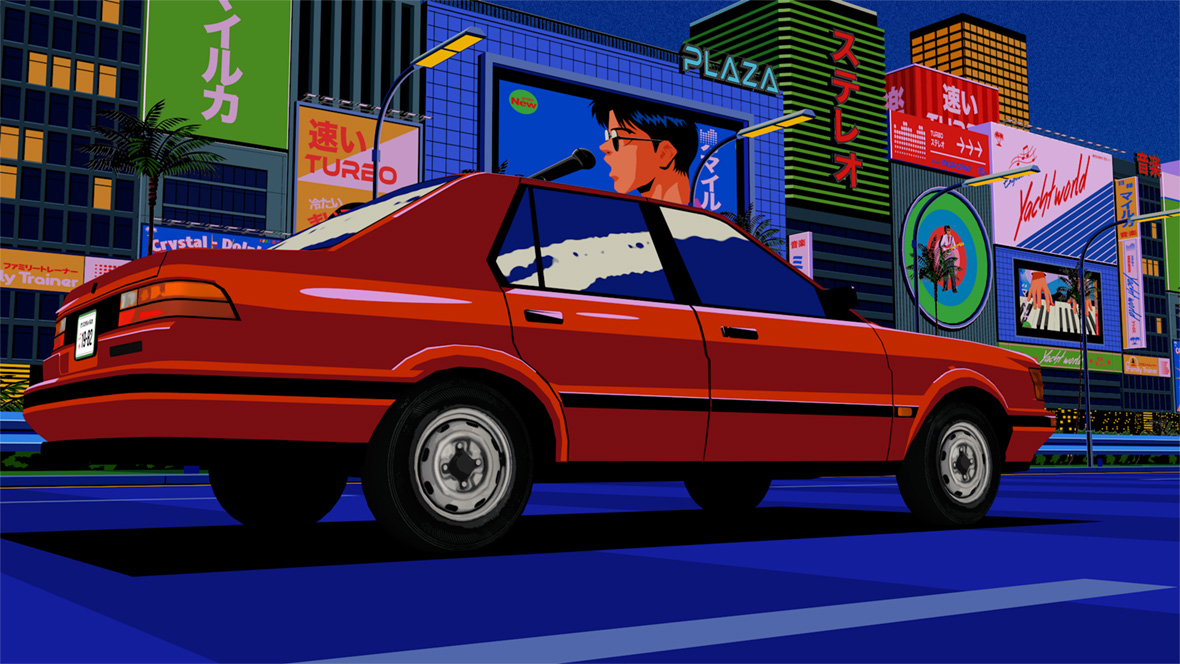
Putra studied film and animation at the Multimedia University in Malaysia. After graduation, he worked as a motion graphic designer at an Indonesian media company, but he found client-based work to be repetitive and unchallenging. So, he began developing his independent art career in his spare time, drafting his retro-infused universe little by little. “I only draw the visuals that matter to me,” he says. “I can draw boomboxes and cassette tapes every day without complaining.”
He’s unclear what exactly fascinates him about such objects. But one thing he is sure of. “I miss the analog era,” he says. “It’s good to create a piece of art or music on your computer and to have all the tools you need right there on your desktop. I truly respect how the process happened before when musicians had to go through analog recording and distribution to release their albums. It was a long process to create something.”
As his signature style caught the public eye, Putra became a sought-after artist and has since taken part in exciting collaborations with several independent musicians, who wanted fun and playful visuals for their videos, album covers, or other promotional materials.
Ardhira 在马来西亚多媒体大学学习电影和动画专业,毕业后进入一家印尼媒体公司,成为了一名动画设计师,但他发现,这些按客户要求设计的作品单调重复,毫无挑战性。于是,他开始用业余时间来发展自己的独立艺术事业,一点一点勾勒出他的复古世界。他说:“和我有关的元素,我都会尝试。即使每天画磁带机和盒式磁带,我也未曾感到厌倦。”
他也不清楚究竟是什么让他对这些物品如此着迷,但有一点他很确定,“我很怀念模拟时代,在自己电脑上创作艺术作品或音乐,所有工具都尽在你的桌面。那个年代的创作过程令人钦佩,音乐人通过模拟录音录制,再发表专辑,那是一个相对漫长的创作过程。”他解释道。
Ardhira 凭借自己独特的艺术风格,迅速成为一名炙手可热的艺术家,并已和多位独立音乐人有过很有趣的合作,为他们的音乐 MV、专辑封面或其他宣传材料创作别具一格的视觉设计。
无法观看?前往腾讯视频
In 2020, American electronic music producer Engelwood asked him to create a music video for Crystal Dolphin, a track sampled from Kingo Hamada’s 1982 Dolphin in Town, an all-time city pop classic. Engelwood’s song had already become a viral sensation on TikTok, with hundreds of millions of streams from the platform’s users—most of them Gen Zs. Engelwood himself was only born in 1996.
Putra came up with a storyline for the music video in which different generations connect through music, from analog to digital, just as it happened with Hamada’s song itself. “What’s been recorded never dies. Like the connection between Kingo Hamada and Engelwood,” he says.
2020 年,美国九零后电子音乐制作人 Engelwood 邀请他为歌曲《Crystal Dolphin》制作音乐视频,该曲目采样自滨田金吾创作于 1982 年的经典 City Pop 作品《Dolphin in Town》(街のドルフィン)。Engelwood 的这首歌在 TikTok 上很火,播放量已达到数以亿计,其中大多数都是 Z 世代。
Ardhira 为这个音乐 MV 设计了一个故事情节,展示了不同世代的人们通过音乐相互连接,从模拟时代到数字时代,正如滨田金吾和 Engelwood 不同年龄层之间的合作一样。“MV 中出现的元素,放在任何时代都不会过时。不同年代的彼此连接,是视频概念的核心。”他说道。
无法观看?前往腾讯视频å
One of Putra’s most recent projects was a music video for Taiwanese musician DJ Didilong’s reinterpretation of Promise, a1975 love hit by Liu Wenzheng. The brief was to create a dreamy romantic atmosphere revolving around a love relationship, so Putra looked through the photographs his parents took at the beginning of their relationship. “There were so many photos that I thought of a camera as the most important object to capture their relationship back in the 1980s,” Putra says.
On a loop effect, the video features a couple’s journey from dating to marriage through the lens of their vintage cameras. The result is palpably warmer and more sentimental than his other works, as there’s a much more emotional narrative and an entirely new color palette inspired by the hues of sunset.
Another challenging aspect of Promise was reproducing Taiwanese settings and text with accuracy. Putra had to be extra careful with designing the Chinese typography, which he wasn’t particularly familiar with. But Putra always welcomes the challenge of finding different ways of expanding his universe. Whether trying out new color schemes or studying cultural references in-depth, he’s happy to experiment, as long it all remains coherent under his retro umbrella.
Ardhira 最新的项目之一是帮台湾音乐人 DJ Didilon 重新诠释台湾歌手刘文正发表于 1975 年的经典情歌《诺言》,描绘一对情侣之间梦幻般的浪漫氛围。为此,Ardhira 特意去翻看了父母刚相恋时拍过的相片。Ardhira 表示:“照片真的太多了。在 1980 年代,相机就是记录他们关系的最重要工具。”
这个音乐 MV 采用循环效果,展示了一对情侣用老式相机,记录他们从约会到结婚的旅程,整个 MV 的风格比他以往的作品显得更温暖和多愁善感,因为其中有更多情感叙述,并采用了以日落为灵感的全新色调。
创作《诺言》MV 时,他要面临的另一个挑战是准确再现当时台湾的环境和氛围。Ardhira 在设计中文字体时要格外小心,因为他也不太懂中文。但他向来乐于迎接挑战,探索新的领域。别说是尝试新的配色,就连当地传统文化他都乐此不疲,只要是他所热衷的复古风格就行。
Putra is always thrilled in revisiting the bygone days of his childhood while creating. “When I started with the retro theme in 2017, I realized I was happy to revisit my childhood memories. It also gave me a new connection with my parents. It had a healing effect on me, like therapy.”
For a long time, psychologists associated nostalgia with depression and the hopeless longing for bygone times. Recently, though, it’s been argued that the feeling has an energizing effect: it links the past to the present and creates hope for the future.
Nostalgia also connects people through common social memories. Putra’s work speaks to his generation. But it resonates with a younger crowd too, people that hardly experienced the 1990s, much less the 1980s, a generation that never played console video games, watched VHS films or listened to cassette tapes. And yet, they, too, feel nostalgic for an era they didn’t live in. “This makes me think of nostalgia as something that can be shared with everyone. I hope they too can look at their childhood memories and feel the joy and healing effect,” he says.
Ardhira 喜欢在创作的过程中重温自己的童年时光。“2017 年我开始以复古主题创作时,那时候我很确信自己喜欢的就是怀旧风,这也能让我和父母建立起新的联系,感觉特别治愈。”
长期以来,心理学家总是将怀旧情绪与抑郁相联系,认为这是对过去的过分沉迷。不过,最近也有声音提出,怀旧的情绪具有振奋人心的作用,因为它能将过去与现在联系起来,并激发人们对未来的更多想象。
除此之外,怀旧还可以通过共同的社会记忆,将人们联系起来。Ardhira 的作品代表的是过去一代人,但也能引起更年轻一代人的共鸣,这些人从未经历过 1990 年代或 1980 年代,也从未玩过卡带游戏机,没用录像带看电影,也没听过盒式磁带。但,他们同样会对这个自己从未生活过的时代充满好奇。“这让我觉得,怀旧是一种可以与每个人分享的感受。人们通过回顾过去,感受到曾经或从未有过的快乐,以得到治愈,”他说。
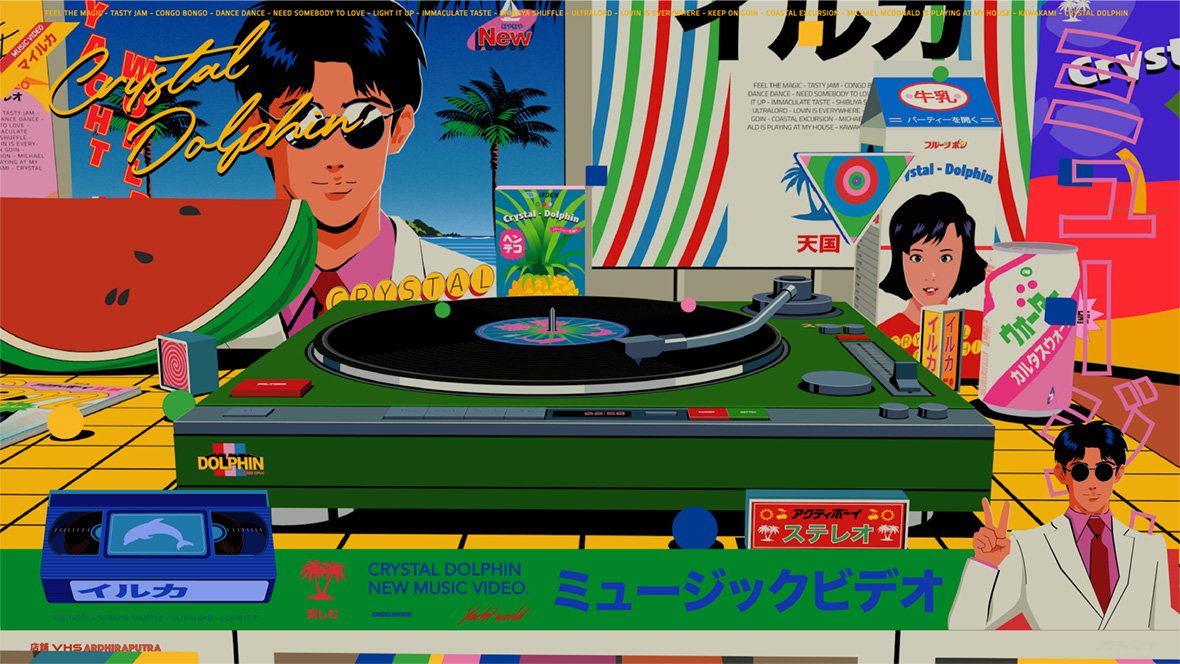
But not all is looking back. As a digital artist, Putra is enthusiastic about new technologies and the possibilities of the internet, a realm he paid close attention to and saw developing over his life. He’s especially fascinated by NFTs. He believes in their sustainable development and potential to open exciting new worlds for artists like him, enabling things he never imagined could happen early in his career.
Putra has recently dropped his first NFT, a collaboration with SuperRare, of the world’s leading crypto art marketplaces. Passing Breeze is a 3D animation depicting the interior of a boy’s bedroom. Once more, it’s an assemblage of his childhood inspirations—all the retro analog paraphernalia he loves thrown into the crypto cosmos.
然而,Ardhira 也并非一味沉迷过去。作为一名数字艺术家,他对新科技和互联网同样充满热情,他见证并密切关注着数字技术的发展。他最近对 NFT(非同质化代币)尤其痴迷,坚信这种技术能获得可持续发展,并能够为他和其他艺术家开启一个令人期待的新时代,让许多他以前从未想过的事情成为现实。
Ardhira 最近推出了他的第一件 NFT 作品,这是他与世界领先加密艺术平台 SuperRare 合作的项目,取名为《Passing Breeze》,是一个 3D 动画作品,描绘了一个男孩的卧室。这个作品同样取材于他的童年时光,只不过这一次,他将自己所热爱的各种复古元素放入了一个加密过的世界。
Like our stories? Follow us on Facebook and Instagram.
Instagram: @ardhiraputra
Behance: ~/ardhira
Contributors: Tomas Pinheiro, Lucas Tinoco
Chinese Translation: Olivia Li

